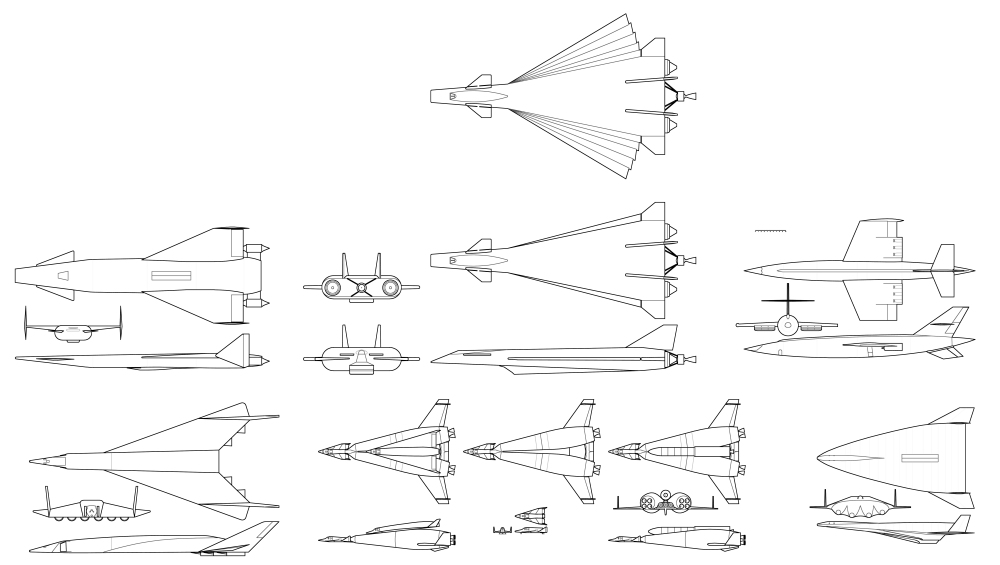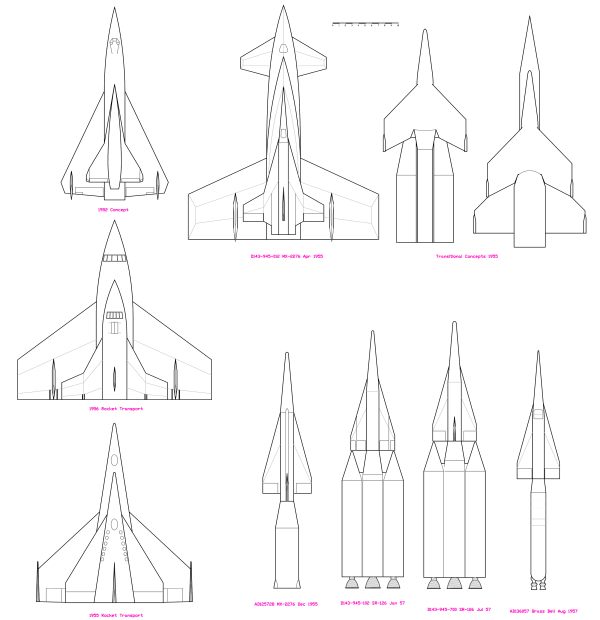From a NASA-MSFC presentation, circa 1963.
For much, much more on Project Orion, see Aerospace Project Review issues V1N3, V1N4, V1N5, V1N6 and V2N2.
Through Monday or so… 20% off any collection of downloadable items totalling more than $65. Since I don’t know how to do that in Paypal script, just email me a list of items you want, and I’ll send you a Paypal “invoice.”

The sale has ended.
The AIAA-Houston branch online magazine “Horizons” for April 2009 had a two page article of mine on the General Dynamics “Nexus” series of SSTO launch vehicles. Payloads starting at a respectable ONE MILLION POUNDS. You can download it and other issues of “Horizons” here:
http://www.aiaa-houston.org/horizons
Note they got the title wrong. Woohoo! I’m not the only one who makes editting goofs!
A sneak peek at Aerospace Projects Review issue V2N5. Aerospaceplane (“ASP”) was an early 1960’s USAF program to develop a practical “orbital airplane,” with multiple bidders turning in a wide range of competing designs based on some wildly differing propulsion systems. Unlike the 30-year later, but largely identical, X-30 NASP competition, in this case the various bidders were not constrained by the government dictating all aspects of the design.

While ASP was certainly well beyond the technological capabilities of the early ’60’s, it cannot be reliably declared that it could not have been made to work if development had been continued. As with far too many aerospace programs, large sums of money were spent, considerable knowledge and talent were gathered… and then it was all pissed away, only to be repeatedly resurrected years later, and then again pissed away. All the money spent on the myriad of “orbital airplane” programs over the years (ASP, Dyna Soar, NASP, X-33, X-34, X-43, etc) could have easily led to an actual vehicle, if only a rational development program had been initiated… and stuck with.
Bah. Anyway, V2N5 of APR will have an article describing a “snapshot” in time of the ASP program, including the above designs.
Now that all 20 of the Dossiers are available (HERE) it’s time to start having sales! So, here’s another one:
Reichdreams Dossiers 11 through 20 would normally cost $143 if purchased separately for download. But for a limited time, you can purchase all ten for $100.
Get ‘em while the getting’s good!
Something that didn;t end up in any of the BoMi articles for APR is the small bit of artwork below.
Bell reports tended to have a lot of “filler art”like this that showed simple sketches of vehicle which might, or might not, have been actual designs. However, the more I see, the more I conclude that most, if not all, of the vehicles sketched were based on at least *some* prior serious design work. This sketch, after all, shows at far left the first stage booster for the MX-2273 BoMi from 1953 (see issue V2N3 of APR for more on this vehicle). The vehicle at right shown in perspective is unknown to me, but the first stage has virtually the same wings as the first true Dyna Soar configuration proposed by the Martin-Bell team… same facetted airfoil, same cranked-delta, same wingtip fins. It’s possible that the Martin-Bell Dyna Soar was based on a prior Bell design for a much larger booster.

The MX-2273 is the second from the left, top row. See APR V2N3 for much more on this design – and many others.
Up and runnign at last. Not the longest issue, with 113 pages… but the biggest in terms of filesize, at over 50 meg. LOTS of illustrations… detailed diagrams, artwork, mockup photos, etc.
http://www.up-ship.com/blog/eAPR/ev2n4.htm
Includes:
Bell BoMi part 3: with Convair RoBo, Super Hustler, Fish and Dyna Soar; Boeing RoBo concepts; Martin RoBo; Bell Dyna Soar CTV
Bell D188A Mach 2 VTOL fighter part 2: scads of diagrams and photos
Convair postwar seaplane bomber studies, by Robert Bradley
Ames Mach 10 demonstrator, by Dennis R. Jenkins
Convair Manned Reconnaissance Glide Vehicle
Boeing Model 767-730 nuclear-powered transport
Again, see here:
At overly long last, it’s written and editted, and converted to PDF (took some doing to get it below 200 megabyteswithout trashing image quality… in the end got it down to 50+ meg). It will be made available sometime this weekend, after I upload it and tinker with the website appropriately. With some exciting new innovations in pricing, as well!
The two main articles are part two of two on the Bell D188A VTOL jet fighter, and part three of three on Project BoMi. With special guest stars Super Hustler, Fish, jet seplane bombers and more!
Here’s the collection of Orion vehicles I built in CAD for APR issue V2N2 , all in scale. The Battleship which is currently being prepped for physical modeling is the fourth from the left on the bottom row. Far right on the bottom is the “Archangel Michael” from Niven & Pournelle’s “Footfall,” as drawn by Aldo Spadoni. Creating this model in the same 1/288 scale as the battleship would certainly be possible, but it’d be fargin *expensive* (probably around $200 as a limited-run resin & fiberglass kit). However, if anyone is interested in this as a kit, let me know via commenting below. If anyone is interested in contracting to have this made especially for you in whatever scale, let me know via email:
![]()
All the major parts are modeled, all the important pins & sockets seem to be in place, parts don’t seem to interfere (the RCS units have been moved slightly aft from what’s shown below to prevent interference with the turret bay doors). Some detailing yet to do, and a couple editing checks to make sure there’s nothing stoooopid, then it’s on to the quotation process.